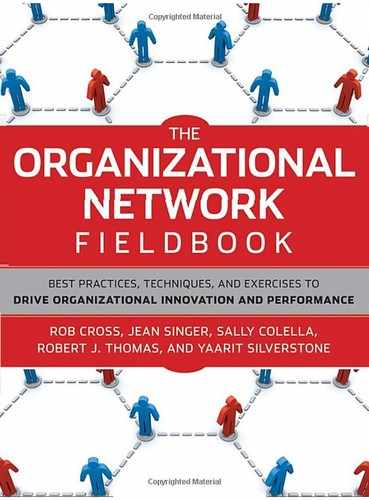12.5. Objective 4: Improve Talent Management
Downing sought to enable people in her unit—whether they were seasoned or new—to manage their networks more effectively, thereby maximizing their productivity and loyalty to the unit. To help them identify and address problems in their networks, she made the following changes.
12.5.1. Show People the State of Their Networks
Downing asked an operations manager to create an internal web site for each person in her unit, showing the current state of his or her network. These sites helped people spot and correct problems in their networks—such as the fact that they were spending too much time interacting with people who weren't helping them generate more billable sales.
12.5.2. Connect New Hires to the Right People
To help newcomers get up to speed quickly and immediately begin building and leveraging relationships, Downing plotted established employees' connectivity against their tenure and then used those findings to teach more recent hires how to get connected. For example, she gave each new hire the names of 10 well-connected people and suggested that he or she go to those individuals for information needed on client engagements.
She also established a network comprising entry-level employees who participated in a biweekly teleconference to discuss common career issues, such as "How can I gain recognition for going the extra mile for colleagues?" and "How can I better manage the demands of my job?"
Finally, Downing set up a job shadowing program, in which new hires were put on a client project for three weeks at no cost to the client other than travel and hotel expenses.
12.5.3. Identify and Document Important Knowledge
To protect her unit from the costs of knowledge lost when employees left, Downing identified the kinds of knowledge embodied in people in central, broker, and peripheral networks. She then identified the people whose departure would prove costliest in terms of lost expertise (and the resulting decrease in the unit's profitability). She assigned the staffing coordinator the task of using staffing, mentoring, and internal projects to promote knowledge sharing by these individuals.
In addition, Downing identified skill areas (such as leadership development) where there were only a few well-connected people in the unit. She documented their knowledge by having analysts listen to and script their client presentations. Then she trained others on the unit's offering in this skill area, using presentations delivered by experts and virtual training seminars. She also got high performers interested in these areas to work on projects with the SMEs, for instance, by developing a new compensation model or collaborating on writing an article. After they had enough experience under their belts, she recommended them for other similar projects and published their achievements on their profiles.
